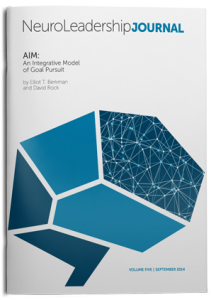Project Description

By ELLIOT T. BERKMAN & DAVID ROCK
Effective goal pursuit is integral to organizational success. Because of this, a large number of models have been developed that describe the process of goal pursuit in whole or part. However, these models often have little overlap with one another, making it unclear how they relate to each other, and they do not incorporate emerging evidence from neuroscience about “brain-friendly” modes of goal pursuit. We solve these two problems by proposing the AIM framework of goals, a neutrally informed model which divides the goal pursuit process into three parts—Antecedents, Integration, and Maintenance.
This framework organizes existing models by describing where in the overall goal pursuit process they fit (e.g., the SMART model is about goal setting, which is an antecedent), and thus has the distinct advantage of being able to integrate across existing models in a meaningful way. Because it is based in neuroscience, the framework can also serve as a bridge between the neuroscience and organizational/leadership fields over which relevant knowledge about brain functioning can be imported into the study of goal pursuit for organizations. In this paper, we briefly review popular models of goals and describe where they fit within the AIM framework, describe each step of AIM and the corresponding current neuroscience knowledge, and then discuss how the AIM framework can set an agenda for future organizational and neuroscience research in this area. This paper is written to be equally relevant to and useful for those pursuing their own goals as well as those facilitating goal pursuit in others.
* These papers are included with individual, corporate, and student memberships. Click here to become a NeuroLeadership Institute member. Already a member? Visit our membership portal.